Related Research Articles

The bass guitar, electric bass or simply bass is the lowest-pitched member of the guitar family. It is a plucked string instrument similar in appearance and construction to an electric or acoustic guitar, but with a longer neck and scale length. The bass guitar most commonly has four strings, though five- and six-stringed models are also relatively popular, and bass guitars with even more strings or courses have been built. Since the mid-1950s, the bass guitar has largely come to replace the double bass in popular music due to its lighter weight, the inclusion of frets in most models, and, most importantly, its design for electric amplification. This is also because the double bass is acoustically compromised for its range in that it is scaled down from the optimal size that would be appropriate for those low notes.

An effects unit, effects processor, or effects pedal is an electronic device that alters the sound of a musical instrument or other audio source through audio signal processing.

Joe Pass was an American jazz guitarist. Although Pass is well known for his work stemming from numerous collaborations with pianist Oscar Peterson and vocalist Ella Fitzgerald, his status as one of the most notable jazz guitarists of the 20th century is generally attributed his work on his solo albums, such as Virtuoso.
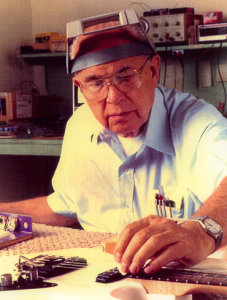
Clarence Leonidas Fender was an American inventor and founder of the Fender Musical Instruments Corporation.
The Fender Stratocaster, colloquially known as the Strat, is a model of electric guitar designed between 1952 and 1954 by Leo Fender, Bill Carson, George Fullerton, and Freddie Tavares. The Fender Musical Instruments Corporation has continuously manufactured the Stratocaster since 1954. It is a double-cutaway guitar, with an extended top "horn" shape for balance. "Stratocaster" and "Strat" are trademark terms belonging to Fender. Guitars that duplicate the Stratocaster by other manufacturers are sometimes called S-Type or ST-type guitars. Many prominent rock musicians have been associated with the Stratocaster for use in studio recording and live performances, most notably Eric Clapton, Buddy Holly, David Gilmour, Mark Knopfler, Jimi Hendrix, Stevie Ray Vaughan, John Frusciante, Jeff Beck, George Harrison, and Tom Petty.

The Fender Musical Instruments Corporation is an American manufacturer and marketer of musical instruments and amplifiers. Fender produces acoustic guitars, bass amplifiers and public address equipment; however, it is best known for its solid-body electric guitars and bass guitars, particularly the Stratocaster, Telecaster, Jaguar, Jazzmaster, Precision Bass, and the Jazz Bass. The company was founded in Fullerton, California, by Clarence Leonidas "Leo" Fender in 1946. Andy Mooney has served as the chief executive officer (CEO) since June 2015.
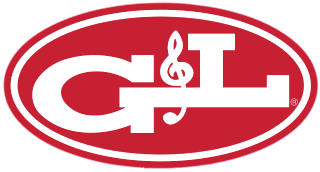
G&L is an American guitar manufacturing company founded by Leo Fender, George Fullerton, and Dale Hyatt in the late 1970s. G&L produces electric guitars and basses with designs based on some classic Fender instruments. The company also produces effects units. G&L's most notable player is Jerry Cantrell, vocalist and guitarist of Alice in Chains, having played several models of the guitar since the '80s, Cantrell also has his own signature Tribute Series Rampage and Superhawk. Cantrell can be seen playing a single-humbucker G&L Rampage in the music video for Alice in Chains' "Man In The Box".
Ernie Ball was an American entrepreneur and musician who developed guitar-related products. Ball began as a club and local television musician and entrepreneur, building an international business in guitars and accessories. Ernie Ball Inc. is the eponymous corporation Ball started to market guitar accessories.
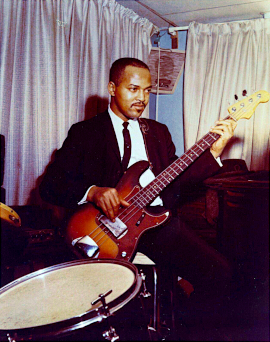
James Lee Jamerson was an American bass player. He was the uncredited bassist on most of the Motown Records hits in the 1960s and early 1970s, and is now regarded as one of the greatest and most influential bass players in modern music history. He was inducted into the Rock and Roll Hall of Fame in 2000. As a session musician he played on twenty-three Billboard Hot 100 number-one hits, as well as fifty-six R&B number-one hits.

Music Man is an American guitar and bass guitar manufacturer. Originally formed in 1971 by Forrest White and Tom Walker, along with Leo Fender as a silent partner, the company started manufacturing electric and bass guitars under the Music Man name in 1974. In 1984 it was acquired by Ernie Ball, and renamed Ernie Ball Music Man.
The Ovation Guitar Company is a manufacturer of string instruments. Ovation primarily manufactures steel-string acoustic guitars and nylon-string guitars, often with pickups for electric amplification. In 2015, it became a subsidiary of Drum Workshop after being acquired from KMCMusicorp.
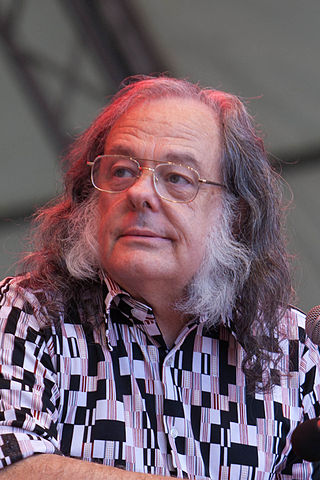
David Perry Lindley was an American musician who founded the rock band El Rayo-X and worked with many other performers including Jackson Browne, Linda Ronstadt, Ry Cooder, Bonnie Raitt, Warren Zevon, Curtis Mayfield and Dolly Parton. He mastered such a wide variety of instruments that Acoustic Guitar magazine referred to him not as a multi-instrumentalist but instead as a "maxi-instrumentalist." On stage, Lindley was known for wearing garishly colored polyester shirts with clashing pants, gaining the nickname the Prince of Polyester.
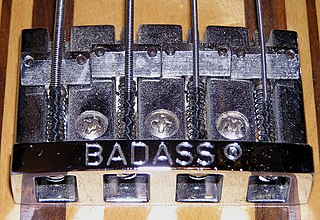
Badass was first trademarked by Leo Quan, a manufacturer of bridges for guitars and basses. Badass bridges feature individually adjustable saddles, which allows for "extremely accurate intonation adjustments." The Badass came on the market in the 1970s, and was made by entrepreneur and guitar repairman Glen Quan, of Marin County music store Bananas At Large and Leo Malliaris of Oakland's Leo's Music. The first Badass bridges were built from diecast zinc and were considered somewhat rough; later models were made from a high-density zinc alloy and more finely milled. Badass is currently owned and distributed by Allparts Music, a subsidiary of Morse Group. In late 2022 and early 2023 Allparts Music relaunched the entire Badass bridge line including the Badass II bass bridge, Badass III bass bridge, Badass V bass bridge, Badass Wraparound Guitar Bridge, and Badass Fine Tuner Guitar Tailpiece.

The Fender Esquire was a solid-body electric guitar manufactured by the Fender Musical Instruments Corporation of Los Angeles. It was the first solid-bodied guitar marketed by the company, and made its debut in 1950.
Tadeo Gomez was a worker at Fender Musical Instrument Manufacturing Company in Fullerton, California in the 1950s. He has become famous amongst players and collectors of electric guitars for the high quality of his work and his habit of signing his name or initials on the guitars he helped to craft.

Maytime is a 1937 American musical and romantic-drama film produced by MGM. It was directed by Robert Z. Leonard, and stars Jeanette MacDonald and Nelson Eddy. The screenplay was rewritten from the book for Sigmund Romberg's 1917 operetta Maytime by Rida Johnson Young, Romberg's librettist; however, only one musical number by Romberg was retained.
The White Steel was a steel guitar made by the Fender company. It was released as a student model in 1956 and was sold with the matching amplifier.

Doc Kauffman was a lap steel guitar, electric guitar engineer, inventor and pioneer of the world's first patented guitar vibrato system. The patent for "Apparatus for producing tremolo effects" was applied for in 1928 and officially granted to Doc Kauffman on January 5, 1932.

Vintage musical equipment is older music gear, including instruments, amplifiers and speakers, sound recording equipment and effects pedals, sought after, maintained and used by record producers, audio engineers and musicians who are interested in historical music genres. While any piece of equipment of sufficient age can be considered vintage, the term is typically applied to instruments and gear from the 1970s and earlier. Guitars, amps, pedals, electric keyboards, sound recording equipment from the 1950s to 1970s are particularly sought after, while musical equipment from the 1940s and earlier is generally far more expensive and sought out mainly by museums or collectors to preserve historical equipment, rather than to perform with.

Chicago Musical Instruments Co. (CMI), later known as Norlin Music, was a manufacturer and distributor of musical instruments, accessories, and equipment, which at times had controlling interests in Gibson Guitars, Standel, Lowrey, F. E. Olds & Son, William Lewis & Son Co., Krauth & Beninghoften, L.D. Heater Music Company, Epiphone Guitars, Selmer UK, Moog, and other musical instrument brands. In the mid-1970s, the company was the largest manufacturer of musical instruments in the United States.
References
- ↑ "California Death Records" Archived 7 July 2011 at the Wayback Machine 27 November 2010
- ↑ "Soul of Tone: Celebrating 60 Years of Fender Amps" Tom Wheeler, 2007, Hal Leonard, ISBN 0634056131 [ page needed ]
- ↑ "Fender: The Inside Story" Forrest White, 1994,Hal Leonard, Page 89, ISBN 0-87930-309-3